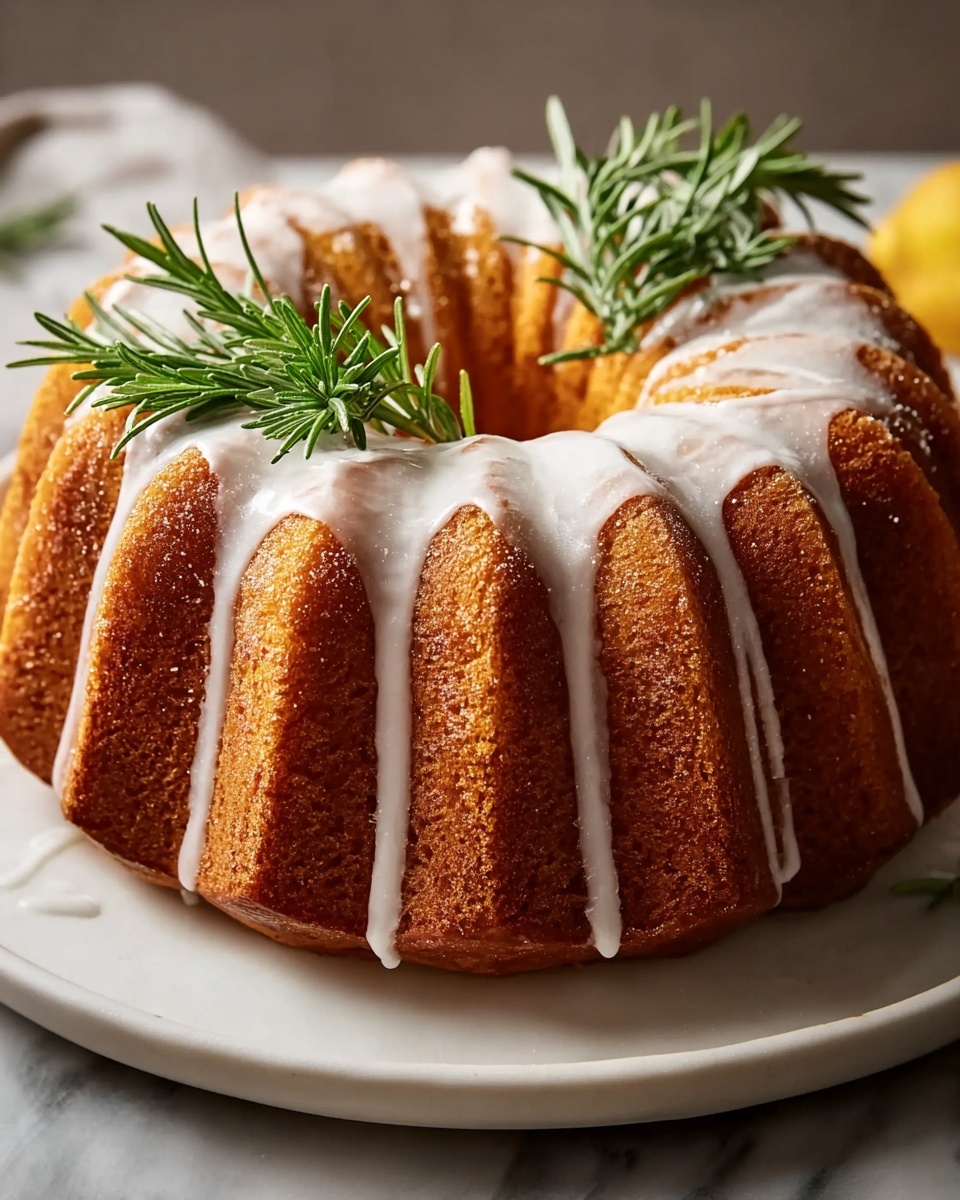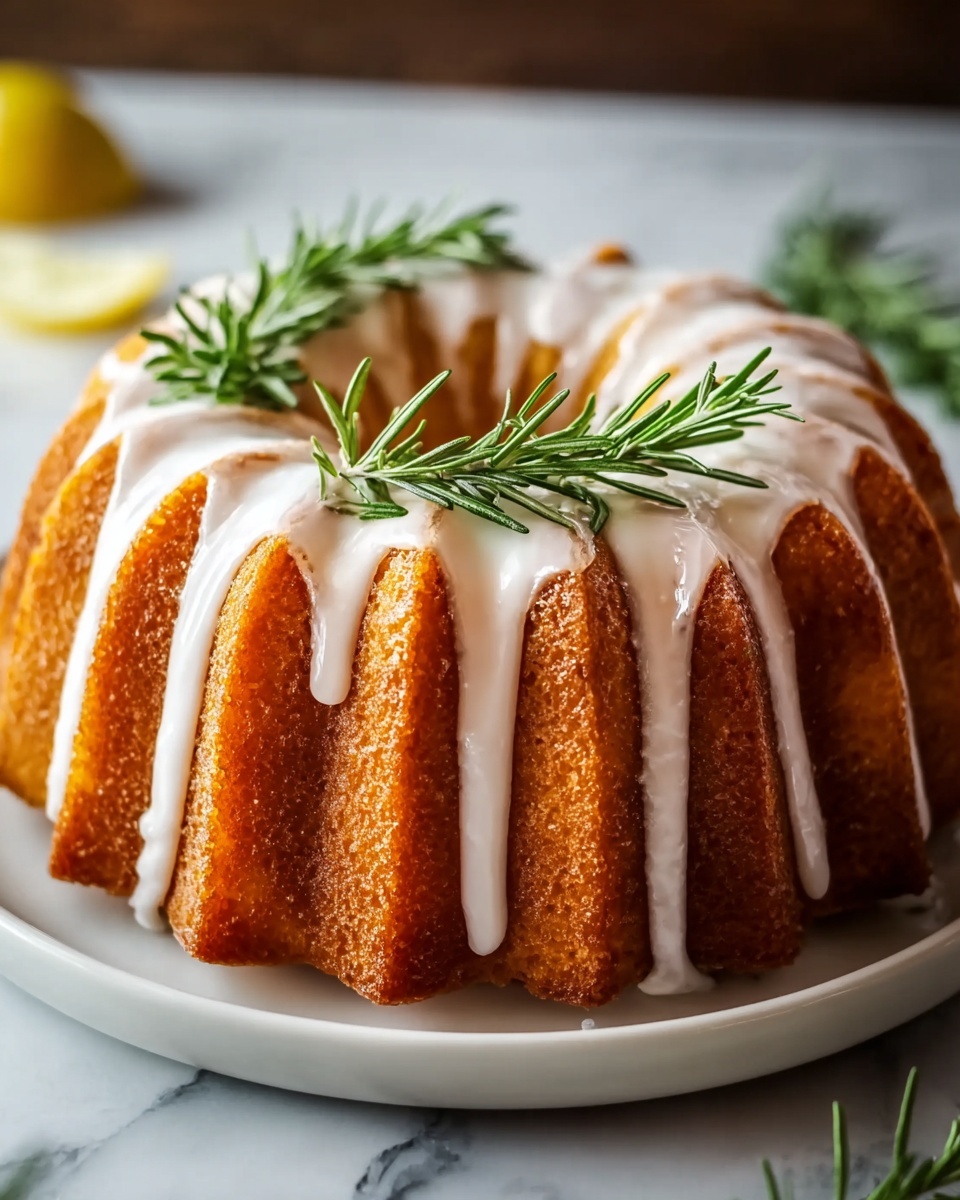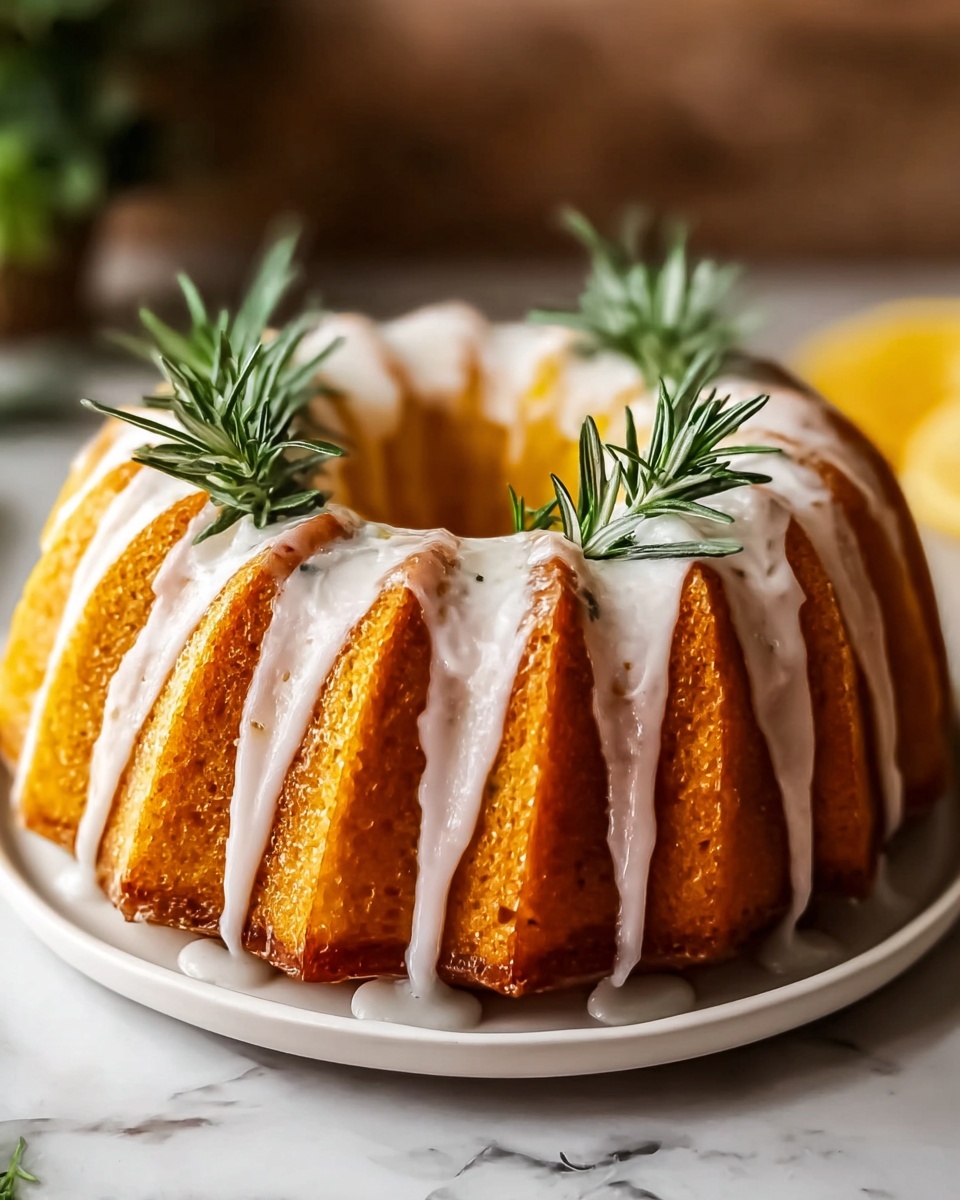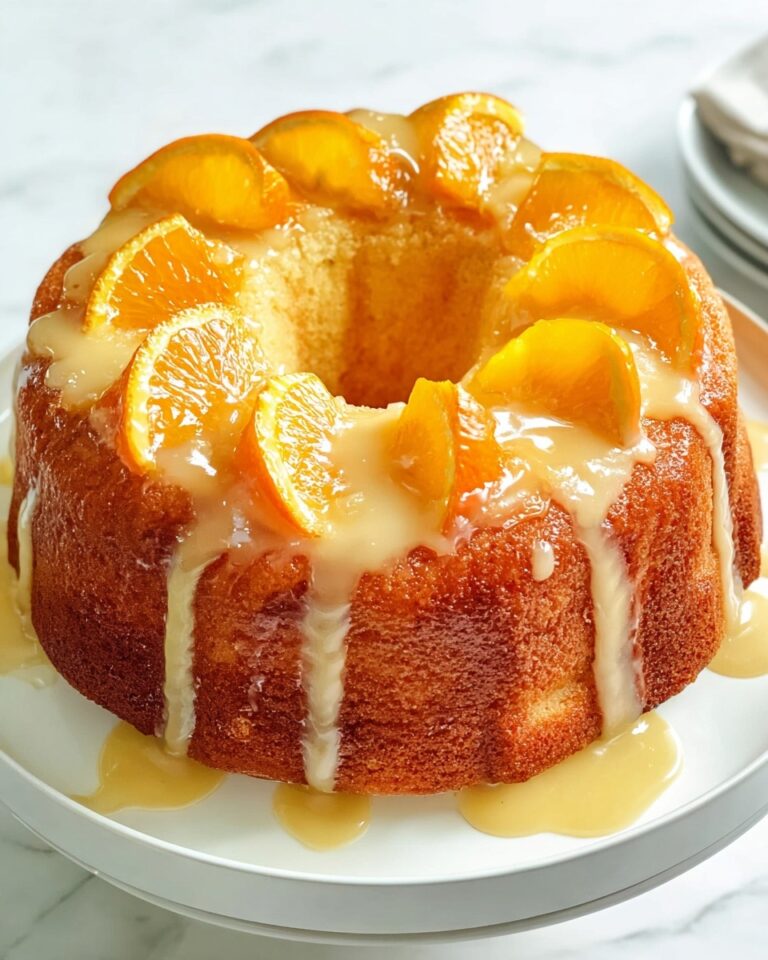If you’re looking for an absolutely delightful treat that feels like sunshine with every bite, the Rosemary-Lemon Bundt Cake with Candied Rosemary Recipe is your perfect go-to. This cake masterfully balances the fresh brightness of lemon with the earthy, aromatic hint of rosemary, making each slice an irresistible experience. The candied rosemary topping adds a charming touch of sweetness and crunch that elevates the presentation and flavor, transforming a simple Bundt cake into a showstopper for any occasion. Whether you’re baking for a cozy afternoon tea or a festive celebration, this recipe will quickly become a beloved classic in your baking repertoire.

Ingredients You’ll Need
Gathering your ingredients is one of the most satisfying parts of baking this Rosemary-Lemon Bundt Cake with Candied Rosemary Recipe. These simple but essential components come together beautifully, where each adds distinct texture, flavor, or charm that creates a harmonious balance in the final cake.
- Unsalted butter (1 1/2 cups or 3 sticks): At room temperature for that perfect creamy base to create moisture and richness.
- All-purpose flour (3 cups, spooned and leveled): Provides structure, making the cake tender yet sturdy.
- Baking soda (1 teaspoon): A leavening agent to help the cake rise light and fluffy.
- Kosher salt (1 1/2 teaspoons): Enhances the flavors and balances the sweetness.
- Granulated sugar (2 cups plus 1/2 cup for candying): Sweetens the cake and creates that wonderful caramelized crunch for the rosemary garnish.
- Lemon zest (1 tablespoon) and lemon juice (2 tablespoons): Adds the signature bright, tangy flavor that wakes up your palate.
- Fresh rosemary (3 tablespoons finely chopped plus 6 sprigs for candying): Offers an aromatic, slightly piney flavor that pairs beautifully with lemon.
- Large eggs (6 for the batter and 1 egg white for candying): For structure and richness; the egg white is perfect for coating your rosemary before candying.
- Pure vanilla extract (1 tablespoon plus 1/4 teaspoon): Deepens the flavor with just a touch of warm sweetness.
- Sour cream (1 cup, at room temperature): Adds moisture and a subtle tang that keeps the cake tender.
- Confectioners’ sugar (1 1/3 cups): Used in the glaze to finish off the cake with a smooth, sweet coat.
- Water (1 tablespoon plus more as needed): Helps adjust the glaze to the perfect consistency.
How to Make Rosemary-Lemon Bundt Cake with Candied Rosemary Recipe
Step 1: Prepare Your Dry Ingredients
Start by whisking together your flour, baking soda, and kosher salt in a medium bowl. This ensures the leavening agent and salt are evenly distributed throughout the flour, which helps the cake rise beautifully and develop perfect texture.
Step 2: Cream Butter, Sugar, Lemon Zest, and Rosemary
In a large mixing bowl, use an electric mixer on medium-high speed to beat the butter, granulated sugar, lemon zest, and finely chopped rosemary until the mixture looks light, fluffy, and fragrant—usually about 3 to 4 minutes. This step aerates the batter and infuses it with the refreshing aromatics.
Step 3: Add Eggs, Vanilla, and Lemon Juice
Reduce your mixer’s speed to medium and add eggs one at a time, beating well after each addition. Follow this with the vanilla extract and lemon juice, blending until everything is fully incorporated. This slow addition helps maintain the fluffy texture and keeps the batter from curdling.
Step 4: Combine Flour Mixture and Sour Cream
Set your mixer to low speed and alternate adding the flour mixture and sour cream, beginning and ending with the flour mixture. Mix just until each addition is combined to avoid overworking the batter, which keeps the final cake tender and moist.
Step 5: Bake the Cake
Pour the batter into a well-buttered and floured Bundt pan, smoothing the top with a spatula. Tap the pan gently against the counter to release any trapped air bubbles. Bake at 350°F (175°C) for 50 to 60 minutes. After 30 minutes, if you notice the cake browning too quickly, shield it loosely with aluminum foil. Check doneness by inserting a toothpick in the center—it should come out with a few loose crumbs but no wet batter.
Step 6: Cool the Cake
Allow the cake to cool in the pan for about 10 minutes to settle, then invert it onto a wire rack to cool completely. This ensures your cake retains its shape and cools evenly before the finishing touches.
Step 7: Make the Candied Rosemary
For the candied rosemary, whip the egg white lightly. Brush the rosemary sprigs with the egg white and dredge them in granulated sugar. Place on parchment paper and let dry at room temperature, giving you that charming, sparkling garnish that brings a burst of flavor and texture to the cake.
Step 8: Prepare the Glaze
Mix together confectioners’ sugar, vanilla extract, pinch of kosher salt, and water until you reach a smooth, pourable glaze. Adjust with additional water as needed. Drizzle this over the cooled Bundt cake and scatter the candied rosemary sprigs on top for a stunning, fragrant finish.
How to Serve Rosemary-Lemon Bundt Cake with Candied Rosemary Recipe

Garnishes
Freshly candied rosemary sprigs serve as both a beautiful and flavorful garnish, giving your cake an elegant, rustic charm. A light dusting of extra lemon zest or a few thin lemon slices can add a pop of color and enhance the citrus aroma, making the cake look as good as it tastes.
Side Dishes
This cake pairs wonderfully with a scoop of vanilla bean ice cream, Greek yogurt drizzled with honey, or a simple berry compote. These accompaniments bring a balance of creaminess or tartness that complements the moist, fragrant cake perfectly.
Creative Ways to Present
Try serving slices alongside a pot of chamomile or Earl Grey tea for a sophisticated afternoon treat. You can also create mini individual Bundt cakes for personal servings, each topped with candied rosemary and a dusting of confectioners’ sugar for impressive party presentations.
Make Ahead and Storage
Storing Leftovers
Store any leftover cake tightly wrapped in plastic wrap or an airtight container at room temperature for up to 3 days to maintain its tenderness and moisture. Keep the glaze and candied rosemary covered separately if you plan to add fresh garnish before serving.
Freezing
You can freeze this Bundt cake for up to 2 months. Wrap it well in plastic wrap and then in foil to prevent freezer burn. Thaw overnight in the refrigerator and then bring to room temperature before glazing and garnishing for the best flavor and texture.
Reheating
To enjoy warm slices, heat them gently in the microwave for about 10 to 15 seconds or warm in the oven at a low temperature for a few minutes. This revives the cake’s softness and highlights the intricate flavors of lemon and rosemary.
FAQs
Can I use dried rosemary instead of fresh?
Fresh rosemary is preferred for this recipe because it has a brighter, more delicate flavor that really complements the lemon. If you must use dried rosemary, reduce the amount since it’s more concentrated, and finely crush it before adding.
What if I don’t have a Bundt pan? Can I use another pan instead?
Absolutely! You can use a tube pan or even two 9-inch round cake pans. Just keep an eye on the baking time, as it may vary slightly. A Bundt pan, however, gives a wonderful presentation and a lovely crust all around.
Is this cake very sweet?
This cake strikes a lovely balance — it’s sweet enough to satisfy cravings but not overpowering. The lemon zest and juice combined with rosemary add brightness and herbal notes that keep it refreshing and sophisticated.
Can I make this cake vegan or dairy-free?
This particular recipe relies on eggs, butter, and sour cream for its texture and richness, making vegan adaptation a bit tricky. However, with specialty substitutes and adjustments, it could be adapted, but the classic version truly shines with its original ingredients.
How do I best preserve the candied rosemary without it getting sticky?
Let the rosemary dry completely at room temperature in a low-humidity environment before storing in an airtight container. If humidity is high, place a desiccant packet inside the container to help keep the candied rosemary crisp.
Final Thoughts
There’s something truly special about the way lemon and rosemary come together in this Rosemary-Lemon Bundt Cake with Candied Rosemary Recipe. It’s fresh, fragrant, and full of character — a perfect way to brighten any day or impress guests with minimal fuss but maximum flavor. I can’t recommend it enough for anyone who loves a cake that’s as stunning to look at as it is to eat. Go ahead, give this recipe a whirl and enjoy the wonderful aroma filling your kitchen as you create a dessert that feels like a warm hug from the inside out.
Print
Rosemary-Lemon Bundt Cake with Candied Rosemary Recipe
- Prep Time: 20 minutes
- Cook Time: 50-60 minutes
- Total Time: 1 hour 20 minutes
- Yield: 12 servings
- Category: Dessert
- Method: Baking
- Cuisine: American
Description
This Rosemary-Lemon Bundt Cake is a delightful and fragrant dessert featuring a moist lemon-infused cake with fresh rosemary incorporated into the batter, topped with a sweet and subtly herbal candied rosemary garnish. The cake is tender, buttery, and brightened by lemon zest and juice, perfectly complemented by a smooth vanilla glaze. Ideal for gatherings and special occasions, this cake balances herbaceous and citrus flavors in every bite.
Ingredients
Cake Ingredients
- 1 1/2 cups (3 sticks) unsalted butter, at room temperature, plus extra for pan
- 3 cups all-purpose flour, spooned and leveled, plus extra for pan
- 1 teaspoon baking soda
- 1 1/2 teaspoons kosher salt
- 2 cups granulated sugar
- 1 tablespoon lemon zest
- 2 tablespoons lemon juice
- 3 tablespoons finely chopped rosemary
- 6 large eggs
- 1 tablespoon pure vanilla extract
- 1 cup sour cream, at room temperature
Candied Rosemary Ingredients
- 1 large egg white
- 1/2 cup granulated sugar
- 6 sprigs rosemary
Glaze Ingredients
- 1 1/3 cups confectioners’ sugar
- 1/4 teaspoon pure vanilla extract
- Pinch kosher salt
- 1 tablespoon water (plus more as needed)
Instructions
- Prepare Dry Ingredients: In a medium bowl, whisk together the all-purpose flour, baking soda, and kosher salt until evenly combined. This ensures your leavening and seasoning are well-distributed throughout the batter.
- Cream Butter and Sugar: Using an electric mixer, beat the room temperature unsalted butter, granulated sugar, lemon zest, and finely chopped rosemary on medium-high speed until the mixture is light, fluffy, and pale in color, about 3 to 4 minutes. This aerates the batter and infuses it with bright citrus and herbal flavors.
- Add Eggs and Flavorings: Reduce the mixer speed to medium and add the eggs one at a time, beating well after each addition to maintain a smooth batter. Then add the pure vanilla extract and lemon juice, mixing until just combined to enhance the cake’s aroma and moisture.
- Combine Flour and Sour Cream: Lower the mixer speed to low. Alternately add the flour mixture and sour cream to the wet ingredients, beginning and ending with the flour mixture. Mix just until incorporated; overmixing can cause a dense cake.
- Prepare Bundt Pan and Bake: Butter a Bundt pan generously and dust with flour, tapping out the excess. Pour the batter into the prepared pan, smoothing the top with a spatula. Gently tap the pan on the countertop to release any trapped air bubbles. Bake in a preheated oven at 350°F (175°C) for 50 to 60 minutes. After 30 minutes, cover the cake loosely with foil if it begins to brown too much. The cake is done when a toothpick inserted into the center comes out with loose crumbs.
- Cool the Cake: Remove the cake from the oven, cool it in the pan for 10 minutes, then carefully invert it onto a wire rack to cool completely. This prevents sogginess caused by condensation inside the pan.
- Make Candied Rosemary: While the cake cools, prepare the candied rosemary. Lightly beat the egg white in a small bowl until frothy. Using a brush, coat each rosemary sprig evenly with the egg white, then dip into the granulated sugar until fully covered. Place the sugared rosemary on parchment or wax paper to dry and harden. This creates a beautifully sweet and crunchy garnish.
- Prepare the Glaze: In a small bowl, whisk together the confectioners’ sugar, vanilla extract, pinch of kosher salt, and 1 tablespoon of water. Add additional water a few drops at a time until the glaze reaches a smooth, pourable consistency.
- Glaze and Decorate: Once the cake is completely cooled, drizzle the glaze evenly over the top, allowing it to drip down the sides. Garnish the cake with the candied rosemary sprigs for an elegant, aromatic finish.
- Serve: Slice and serve the cake at room temperature. It pairs wonderfully with tea or coffee and makes a stunning centerpiece for any dessert table.
Notes
- Ensure butter and sour cream are at room temperature for a smooth batter.
- Do not overmix the batter once dry ingredients are added to avoid a dense texture.
- Use fresh rosemary for the best herbal flavor and visually appealing garnish.
- The candied rosemary can be prepared ahead of time and stored in an airtight container.
- Substitute sour cream with Greek yogurt as a lighter alternative, though texture may vary slightly.
- Store leftover cake in an airtight container at room temperature for up to 3 days or refrigerated for up to a week.








